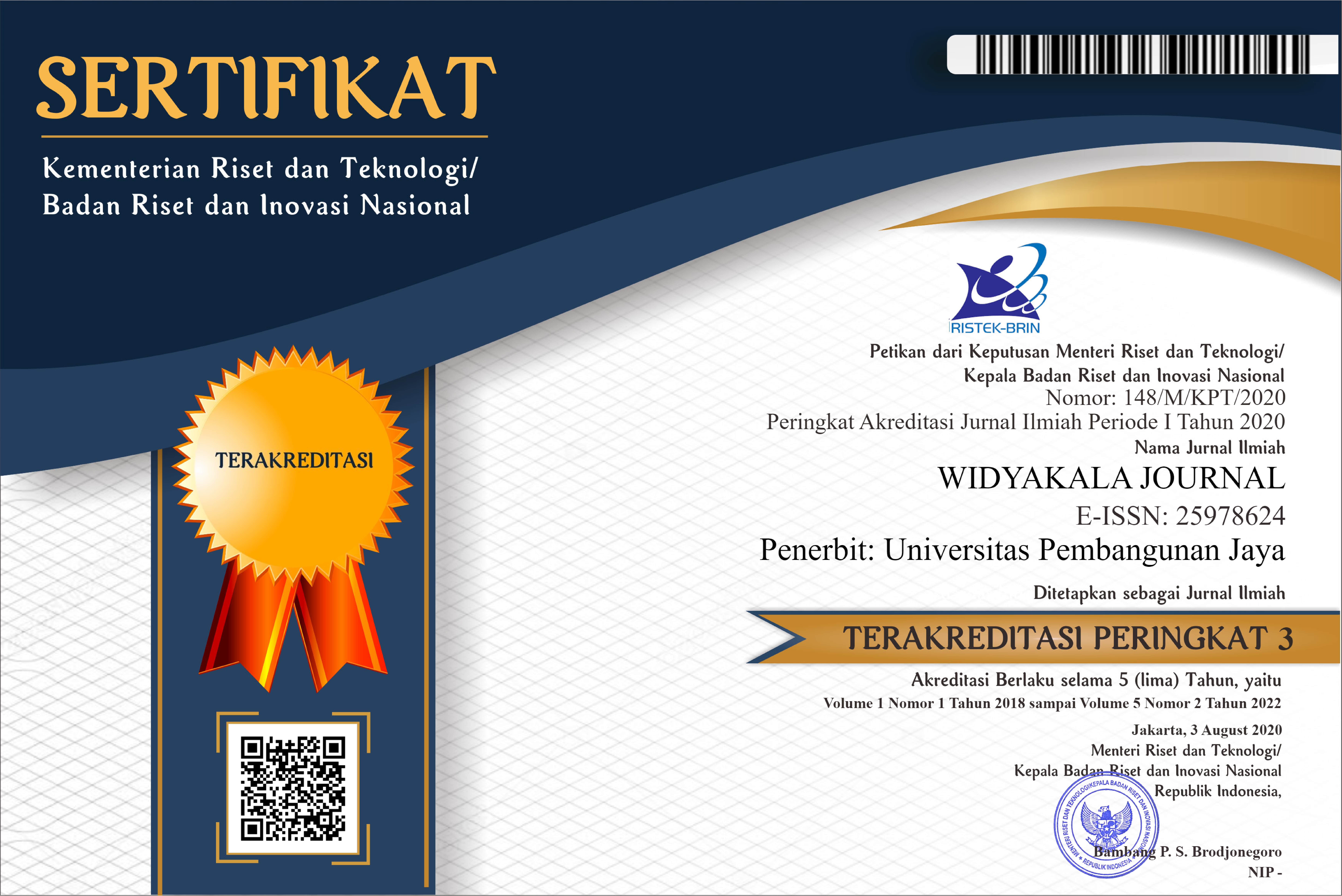Updated, March 2025
Generation Z's Determinants for Using Online Food Delivery in Jakarta
Abstract
One of the Indonesia's leading online food delivery services is Shopee Food. It has competed with other big players. This application has caught the attention of users, even those from the Z generation, who are known for their easy-to-move characteristics and are close to technological applications but sensitive to user experience. This generation's convenience is influenced by many factors. This study analyzes the factors that influence attitudes and behavior for sustainable use of this application in Jakarta. Quantitative data is collected using a survey and questionnaire. This PLS-SEM modeling study shows that after using the service in this application, the user's hedonic motivation must be followed by comfort and usability. The user will evaluate the post-use usefulness of the previous experience to form an attitude toward the next perceived experience. Behavioral intentions toward sustainable use are encouraged. This study highlights the importance of usability and ease of use in determining user comfort. Generation Z does not easily form positive usage attitudes until the benefits of the next experience are the same or better.
Keywords
Full Text:
PDFReferences
Al-Maroof, R. A. S., & Al-Emran, M. (2018). Students Acceptance of Google Classroom: An Exploratory Study using PLS-SEM Approach. International Journal of Emerging Technologies in Learning (IJET), 13(06 SE-Papers), 112–123. https://doi.org/10.3991/ijet.v13i06.8275
Alavi, S. A., Rezaei, S., Valaei, N., & Wan Ismail, W. K. (2016). Examining shopping mall consumer decision-making styles, satisfaction and purchase intention. The International Review of Retail, Distribution and Consumer Research, 26(3), 272–303. https://doi.org/10.1080/09593969.2015.1096808
Ali, G. A., Hilman, H., & Gorondutse, A. H. (2020). Effect of entrepreneurial orientation, market orientation and total quality management on performance Evidence from Saudi SMEs. Benchmarking: An International Journal, 27(4), 1503–1531. https://doi.org/10.1108/BIJ-08-2019-0391
Anderson, R. E., & Srinivasan, S. S. (2003). E-satisfaction and e-loyalty: A contingency framework. Psychology & Marketing, 20(2), 123–138. https://doi.org/https://doi.org/10.1002/mar.10063
Anouze, A. L. M., & Alamro, A. S. (2020). Factors affecting intention to use e-banking in Jordan. International Journal of Bank Marketing, 38(1), 86–112. https://doi.org/10.1108/IJBM-10-2018-0271
Barati, M., Taheri-Kharameh, Z., Farghadani, Z., & Rásky, É. (2019). Validity and Reliability Evaluation of the Persian Version of the Heart Failure-Specific Health Literacy Scale. International Journal of Community Based Nursing and Midwifery, 7(3), 222–230. https://doi.org/10.30476/IJCBNM.2019.44997
Bassiouni, D. H., & Hackley, C. (2014). ‘Generation Z’ children’s adaptation to digital consumer culture: A critical literature review. Journal of Customer Behaviour, 13(2), 113–133. https://doi.org/10.1362/147539214X14024779483591
Belanche, D., Casaló, L. V, & Guinalíu, M. (2012). Website usability, consumer satisfaction and the intention to use a website: The moderating effect of perceived risk. Journal of Retailing and Consumer Services, 19(1), 124–132. https://doi.org/https://doi.org/10.1016/j.jretconser.2011.11.001
Benitez, J., Henseler, J., Castillo, A., & Schuberth, F. (2020). How to perform and report an impactful analysis using partial least squares: Guidelines for confirmatory and explanatory IS research. Information & Management, 57(103168), 1–16. https://doi.org/10.1016/j.im.2019.05.003
Bhattacherjee, A. (2001). Understanding Information Systems Continuance: An Expectation-Confirmation Model. MIS Quarterly, 25(3), 351–370. https://doi.org/10.2307/3250921
Bhattacherjee, A., Perols, J., & Sanford, C. (2008). Information Technology Continuance: A Theoretic Extension and Empirical Test. Journal of Computer Information Systems, 49(1), 17–26. https://doi.org/10.1080/08874417.2008.11645302
Bilgihan, A. (2016). Gen Y customer loyalty in online shopping: An integrated model of trust, user experience and branding. Computers in Human Behavior, 61, 103–113. https://doi.org/https://doi.org/10.1016/j.chb.2016.03.014
Bui, M., & Kemp, E. (2013). E‐tail emotion regulation: examining online hedonic product purchases. International Journal of Retail & Distribution Management, 41(2), 155–170. https://doi.org/10.1108/09590551311304338
Chang, C.-C., Yan, C.-F., & Tseng, J.-S. (2012). Perceived convenience in an extended technology acceptance model: Mobile technology and English learning for college students. Australasian Journal of Educational Technology, 28(5 SE-Articles). https://doi.org/10.14742/ajet.818
Childers, T. L., Carr, C. L., Peck, J., & Carson, S. (2001). Hedonic and utilitarian motivations for online retail shopping behavior. Journal of Retailing, 77(4), 511–535. https://doi.org/https://doi.org/10.1016/S0022-4359(01)00056-2
Christian, M., Girsang, L., & Yulita, H. (2022). Measuring Ease of Use Aspects of Shopee Usage Behavior during Pandemic using PLS-SEM Approach. Proceedings of the 1st International Conference on Emerging Issues in Humanity Studies and Social Sciences - ICE-HUMS, 192–197. https://doi.org/10.5220/0010750000003112
Christian, M., Pardede, R., & Indriyarti, E. R. (2022). Generation Z in Jakarta’s Attitude Towards COVID-19 Ad Distribution on YouTube. Journal of Distribution Science, 20(3), 13–22. https://doi.org/10.15722/jds.20.03.202203.13
Christian, M., Purwanto, E., & Wibowo, S. (2020). Technostress Creators on Teaching Performance of Private Universities in Jakarta During Covid-19 Pandemic. Technology Reports of Kansai University, 62(6), 2799–2809.
Christian, M., Wibowo, S., Indriyarti, E. R., Sunarno, S., & Yuniarto, Y. (2022). Do Service Quality and Satisfaction Affect the Intention of Using Application-Based Land Transportation? A Study on Generation YZ in Jakarta. In Studies in Systems, Decision and Control (Vol. 216). https://doi.org/10.1007/978-3-031-10212-7_60
Christian, M., Wibowo, S., Indriyarti, E. R., Sunarno, S., & Yuniarto, Y. (2023). Do Service Quality and Satisfaction Affect the Intention of Using Application-Based Land Transportation? A Study on Generation YZ in Jakarta BT - The Implementation of Smart Technologies for Business Success and Sustainability: During COVID-19 Crises in D. In
A. Hamdan, H. M. Shoaib, B. Alareeni, & R. Hamdan (Eds.), The Implementation of Smart Technologies for Business Success and Sustainability (pp. 737–746). Springer International Publishing. https://doi.org/10.1007/978-3-031-10212-7_60
Chun, H., Lee, H., & Kim, D. (2012). The integrated model of smartphone adoption: hedonic and utilitarian value perceptions of smartphones among Korean college students. Cyberpsychology, Behavior and Social Networking, 15(9), 473–479. https://doi.org/10.1089/cyber.2012.0140
Di Pietro, L., Pantano, E., & Di Virgilio, F. (2014). Frontline employees׳ attitudes towards self-service technologies: Threats or opportunity for job performance? Journal of Retailing and Consumer Services, 21(5), 844–850. https://doi.org/https://doi.org/10.1016/j.jretconser.2014.02.014
Ernst, C.-P. H. (2015). Risk Hurts Fun: The Influence of Perceived Privacy Risk on Social Network Site Usage BT - Factors Driving Social Network Site Usage (C.-P. H. Ernst (ed.); pp. 45–56). Springer Fachmedien Wiesbaden. https://doi.org/10.1007/978-3-658-09918-3_4
Escobar-Rodríguez, T., & Carvajal-Trujillo, E. (2013). Online drivers of consumer purchase of website airline tickets. Journal of Air Transport Management, 32, 58–64. https://doi.org/10.1016/j.jairtraman.2013.06.018
Escobar-Rodríguez, T., & Carvajal-Trujillo, E. (2014). Online purchasing tickets for low cost carriers: An application of the unified theory of acceptance and use of technology (UTAUT) model. Tourism Management, 43, 70–88. https://doi.org/10.1016/j.tourman.2014.01.017
Hasan, A., Ahn, S., Rameezdeen, R., & Baroudi, B. (2021). Investigation into post-adoption usage of mobile ICTs in Australian construction projects. Engineering, Construction and Architectural Management, 28(1), 351–371. https://doi.org/10.1108/ECAM-05-2019-0277
Indriyarti, E. R., Christian, M., Yulita, H., Aryati, T., & Arsjah, R. J. (2023). Digital Bank Channel Distribution: Predictors of Usage Attitudes in Jakarta’s Gen Z. Journal of Distribution Science, 21(2), 21–34. https://doi.org/10.15722/jds.21.02.202302.21
Indriyarti, E. R., Christian, M., Yulita, H., Ruminda, M., Sunarno, S., & Wibowo, S. (2022). Online Food Delivery App Distribution and Determinants of Jakarta’s Gen Z Spending Habits. Journal of Distribution Science, 20(7), 73–86. https://doi.org/10.15722/jds.20.07.202207.73
Kang, J., & Park‐Poaps, H. (2010). Hedonic and utilitarian shopping motivations of fashion leadership. Journal of Fashion Marketing and Management: An International Journal, 14(2), 312–328. https://doi.org/10.1108/13612021011046138
Kaur, S. J., Ali, L., Hassan, M. K., & Al-Emran, M. (2021). Adoption of digital banking channels in an emerging economy: exploring the role of in-branch efforts. Journal of Financial Services Marketing, 26, 107–121. https://doi.org/10.1057/s41264-020-00082-w
Khajehzadeh, S., Oppewal, H., & Tojib, D. (2014). Consumer responses to mobile coupons: The roles of shopping motivation and regulatory fit. Journal of Business Research, 67(11), 2447–2455. https://doi.org/https://doi.org/10.1016/j.jbusres.2014.02.012
Kuo, Y.-F., & Yen, S.-N. (2009). Towards an understanding of the behavioral intention to use 3G mobile value-added services. Computers in Human Behavior, 25(1), 103–110. https://doi.org/https://doi.org/10.1016/j.chb.2008.07.007
Lara-Rubio, J., Villarejo-Ramos, A. F., & Liébana-Cabanillas, F. (2021). Explanatory and predictive model of the adoption of P2P payment systems. Behaviour & Information Technology, 40(6), 528–541. https://doi.org/10.1080/0144929X.2019.1706637
Memon, A. H., & Rahman, I. A. (2014). SEM-PLS Analysis of Inhibiting Factors of Cost Performance for Large Construction Projects in Malaysia: Perspective of Clients and Consultants. The Scientific World Journal, 2014(165158), 1–9. https://doi.org/10.1155/2014/165158
Mittal, A., Aggarwal, A., & Mittal, R. (2020). Predicting University Students’ Adoption of Mobile News Applications: The Role of Perceived Hedonic Value and News Motivation. International Journal of E-Services and Mobile Applications, 12(4), 42–59. https://doi.org/10.4018/IJESMA.2020100103
Mukminin, A. A., Semmaila, B., & Ramlawati, R. (2020). Effect of Education and Training, work discipline and Organizational Culture on Employee Performance. Point of View ResearchManagement, 1(3), 19–28.
Nath, R., Bhal, K. T., & Kapoor, G. T. (2013). Factors influencing IT Adoption by Bank Employees: An Extended TAM Approach. Vikalpa, 38(4), 83–96. https://doi.org/10.1177/0256090920130406
Otache, I. (2019). The mediating effect of teamwork on the relationship between strategic orientation and performance of Nigerian banks. European Business Review, 31(5), 744–760. https://doi.org/10.1108/EBR-10-2017-0183
Park, E., & Joon Kim, K. (2013). User acceptance of long‐term evolution (LTE) services. Program, 47(2), 188–205. https://doi.org/10.1108/00330331311313762
Park, N., Rhoads, M., Hou, J., & Lee, K. M. (2014). Understanding the acceptance of teleconferencing systems among employees: An extension of the technology acceptance model. Computers in Human Behavior, 39, 118–127. https://doi.org/https://doi.org/10.1016/j.chb.2014.05.048
Rezaei, S., Ali, F., Amin, M., & Jayashree, S. (2016). Online impulse buying of tourism products. Journal of Hospitality and Tourism Technology, 7(1), 60–83. https://doi.org/10.1108/JHTT-03-2015-0018
Rezaei, S., & Ghodsi, S. S. (2014). Does value matters in playing online game? An empirical study among massively multiplayer online role-playing games (MMORPGs). Computers in Human Behavior, 35, 252–266. https://doi.org/https://doi.org/10.1016/j.chb.2014.03.002
Rezaei, S., Shahijan, M. K., Amin, M., & Ismail, W. K. W. (2016). Determinants of App Stores Continuance Behavior: A PLS Path Modelling Approach. Journal of Internet Commerce, 15(4), 408–440. https://doi.org/10.1080/15332861.2016.1256749
Roy, S. K., Balaji, M. S., Kesharwani, A., & Sekhon, H. (2017). Predicting Internet banking adoption in India: a perceived risk perspective. Journal of Strategic Marketing, 25(5–6), 418–438. https://doi.org/10.1080/0965254X.2016.1148771
Saber Chtourou, M., & Souiden, N. (2010). Rethinking the TAM model: time to consider fun. Journal of Consumer Marketing, 27(4), 336–344. https://doi.org/10.1108/07363761011052378
Safira, M., & Chikaraishi, M. (2022). The impact of online food delivery service on eating-out behavior: a case of Multi-Service Transport Platforms (MSTPs) in Indonesia. Transportation. https://doi.org/10.1007/s11116-022-10307-7
Sarstedt, M., Ringle, C. M., Cheah, J.-H., Ting, H., Moisescu, O. I., & Radomir, L. (2019). Structural model robustness checks in PLS-SEM. Tourism Economics, 26(4), 531–554. https://doi.org/10.1177/1354816618823921
Schijns, J. M. C. (2021). Measuring service quality at an online university: using PLS-SEM with archival data. Tertiary Education and Management, 27(2), 161–185. https://doi.org/10.1007/s11233-021-09071-7
Sharma, S. ., & Govindaluri, S. . (2014). Internet banking adoption in India: structural equation modeling approach. Journal of Indian Business Research, 6(2), 155–169.
Singh, N., Sinha, N., & Liébana-Cabanillas, F. J. (2020). Determining factors in the adoption and recommendation of mobile wallet services in India: Analysis of the effect of innovativeness, stress to use and social influence. International Journal of Information Management, 50, 191–205. https://doi.org/https://doi.org/10.1016/j.ijinfomgt.2019.05.022
Taylor, S., & Todd, P. A. (1995). Understanding Information Technology Usage: A Test of Competing Models. Information Systems Research, 6(2), 144–176. https://doi.org/10.1287/isre.6.2.144
Tenggara Strategics. (2022). Online Food Delivery (OFD) Consumption Behavior and Perception Survey in Indonesia. https://tenggara.id/research/Online-Food-Delivery-OFD-Consumption-Behavior-and-Perception-Survey-in-Indonesia
To, P.-L., Liao, C., & Lin, T.-H. (2007). Shopping motivations on Internet: A study based on utilitarian and hedonic value. Technovation, 27(12), 774–787. https://doi.org/https://doi.org/10.1016/j.technovation.2007.01.001
Vărzaru, A. A., Bocean, C. G., Rotea, C. C., & Budică-Iacob, A.-F. (2021). Assessing Antecedents of Behavioral Intention to Use Mobile Technologies in E-Commerce. In Electronics (Vol. 10, Issue 18). https://doi.org/10.3390/electronics10182231
Venkatesh, V., Thong, J. Y. L., & Xu, X. (2012). Consumer Acceptance and Use of Information Technology: Extending the Unified Theory of Acceptance and Use of Technology. MIS Quarterly, 36(1), 157–178. https://doi.org/10.2307/41410412
Wolf, E. J., Harrington, K. M., Clark, S. L., & Miller, M. W. (2013). Sample Size Requirements for Structural Equation Models: An Evaluation of Power, Bias, and Solution Propriety. Educational and Psychological Measurement, 73(6), 913–934. https://doi.org/10.1177/0013164413495237
Yeo, V. C. S., Goh, S.-K., & Rezaei, S. (2017). Consumer experiences, attitude and behavioral intention toward online food delivery (OFD) services. Journal of Retailing and Consumer Services, 35, 150–162. https://doi.org/10.1016/j.jretconser.2016.12.013
Zhao, Q., Chen, C.-D., & Wang, J.-L. (2016). The effects of psychological ownership and TAM on social media loyalty: An integrated model. Telematics and Informatics, 33(4), 959–972. https://doi.org/https://doi.org/10.1016/j.tele.2016.02.007
Zhou, T., & Lu, Y. (2011). Examining Postadoption Usage of Mobile Services From a Dual Perspective of Enablers and Inhibitors. International Journal of Human–Computer Interaction, 27(12), 1177–1191. https://doi.org/10.1080/10447318.2011.565717
DOI: https://doi.org/10.36262/widyakala.v10i1.701
Refbacks
- There are currently no refbacks.
Copyright (c) 2023 WIDYAKALA: JOURNAL OF PEMBANGUNAN JAYA UNIVERSITY

This work is licensed under a Creative Commons Attribution-ShareAlike 4.0 International License.
Redaksi Jurnal Widyakala
Lembaga Penelitian dan Pengabdian Kepada Masyarakat (LP2M)
Universitas Pembangunan Jaya
Jalan Cendrawasih Raya Blok B7/P, Sawah Baru, Ciputat, 15413
Telp : 021-7455555 ext 1311
widyakala.journal@upj.ac.id


















